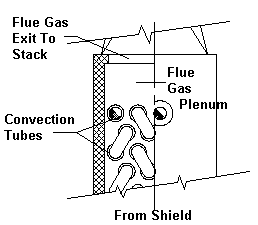Convection Section
 |
The convection section is located in the cooler flue gas stream. It often contains rows of extended surface tubes to improve the efficiency of the furnace. The flue gases can be cooled to a very low temperature, but caution must be used to avoid going below the dew point of the flue gas with the metal temperature of the tubes or surface, since this could cause corrosion. |
Modern convection sections frequently use extended surface to increase the overall heat transfer efficiency of the fired heater. The most common extended surfaces are of the following types.
Segmented Fins:These are usually one of the two types shown below.
| High Frequency Continuously Welded |
||
| Standard Frequency Spot Welded |
The standard frequency, spot welded, design is not used in fired heaters very often since this design is normally selected when using very thin, high density finning such as in a large heat recovery boiler. Most fired heater convections seldom use fins less than 0.049 inch thick. The standard frequency, spot welded fin also has a foot which presents a place where corrosion can occur if flue gases are corrosive or moisture is present.
Solid Fins:These are the most popular fins for modern fired heaters.
| High Frequency Continuously Welded |
These are used generally when the fuel is No. 6 or higher.
| Resistance Welded |
Thermal rating procedures for all these extended surface types are presented in section 4, Heat Transfer Concepts. Both segmented fin types are rated using the same formulas.
Disclaimer:
The formulas and correlations presented herein are all in the public domain and are to be used only as a learning tool. Note that any product, process, or technology in this document may be the subject of other intellectual property rights reserved by sponsors or contributors to this site. This publication is provided as is, without any warranty of any kind, either expressed or implied, including, but not limited to, the implied warranties of fitness for a particular purpose, or non-infringement.
The formulas, correlations, and methods presented herein should not be considered as being recommended by or used by the sponsors of this site. The purpose of this site is educational and the methods may or may not be suitable for actual design of equipment. Only a fired heater design engineer is qualified to decide if a calculation or procedure is correct for an application.